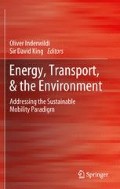Abstract
This chapter addresses how technological innovation in agribusiness should strengthen the synergies among different feedstock production systems, lower carbon footprint and create new business ventures based on bioenergy and bioproducts. We draw on examples from sugarcane from Brazil, where multiple feedstock production systems are being deployed for the production of bioenergy, biofuels and bioproducts, creating operational models for biorefineries. We make the case that sustainable mobility frameworks based on biofuels depend more on how agricultural landscapes are used, than on the feedstock conversion systems themselves. The production of multiple feedstock products at landscape level is crucial for sustainable mobility because it optimizes land use, diversifies the sources of income from farmers, reduces the food versus fuel competition and reduces biofuel carbon footprint. We also present an assessment of the biodiesel program in Brazil, which was launched in 2005 and is currently blended with diesel at a mandatory 5% level. By November 1, 2011, the world population will have reached 7 billion people and more likely by 2050, 9 billion, a demographic turning point as well as a major shift in global geopolitics and consumption patterns of food, energy, water and other resources. The challenges that this presents will continue to be the case for the foreseeable future, while climatic instability and increased severity of pests and disease will affect our capacity to produce goods and services. Agriculture must be at the center of supplying food in quantity and quality necessary to feed an aging population, with people living longer and healthier lives. But several looming challenges remain which must be addressed for agriculture to be successful in fulfilling these needs in a sustainable manner and requires a global coordinated effort. Feeding 9 billion people in 2050 will require the development of new agribusiness models, new technologies and innovative ways of delivering an array of bioproducts from multi-functional agricultural landscapes. Innovation at different feedstock chains can also mitigate price volatility associated with the uncertainties of single product delivery, and the development of competencies and distinctiveness of the bioenergy and bioproducts coming from these landscapes, and thus contributing to sustainable mobility frameworks based on biofuels.
Access this chapter
Tax calculation will be finalised at checkout
Purchases are for personal use only
References
Campos BC (2006) Dinâmica do carbono em latossolo vermelho sob sistemas de preparo de solo e de culturas. Santa Maria, RS. Tese (doutorado)—Universidade Federal de Santa Maria
Cerri CC (1986) Dinâmica da matéria orgânica do solo no agrossistema cana-de-açúcar. Tese (livre docência). Escola Superior de Agricultura “Luiz de Queiroz”, Piracicaba
D’andrea AF, Silva MLN, Curi N, Guilherme LRG (2004) Estoque de carbono e nitrogênio e formas de nitrogênio mineral em um solo submetido a diferentes sistemas de manejo. In: Pesquisa agropecuária brasileira, Brasília, vol 39, no 2, p 179–186, fev 2004
Dedini (2008) Dedini lança usina de açúcar e etanol produtora de água. Press release. Dedini S.A. Indústria de Base, Piracicaba
Fornasieri F, Domingos VI (1978) Nutrição e adubação mineral do algodoeiro. In: Galdos MV (2007) Dinâmica do carbono do solo no agrossistema cana-de-açúcar. Tese (doutorado)—Escola Superior de Agricultura “Luiz de Queiroz”, Piracicaba
International Food Policy Research Institute (IFPRI) (2010) Modeling the global trade and environmental impacts of biofuel policies. http://www.ifpri.org/publication/modeling-global-trade-and-environmental-impacts-biofuel-policies. Accessed 19 Aug 2011
International Energy Agency (2004–2006) www.iea.org. International Energy Agency, Paris
Jantalia CP (2005) Estudo de sistemas de uso do solo e rotações de culturas em sistemas agrícolas brasileiros: dinâmica de nitrogênio e carbono no sistema solo—planta—atmosfera. Tese (doutorado)—Universidade Federal Rural do Rio de Janeiro, Rio de Janeiro
Lardy LC, Brossard M, Assad MLL, Laurent JY (2002) Carbon and phosphorus stocks of clayey ferrassols in Cerrado native and agroecossystems, Brazil. Agric Ecosyst Environ 92:147–158. In: Aduan RE (2003) Respiração de solos e cilcagem de carbono em cerrado nativo e pastagem no Brasil central. Tese (doutorado)—Universidade de Brasília, Brasília
Neves CSVJ, Feller C, Larré-Larrouy M-C (2005) Matéria orgânica nas frações granulométricas de um latossolo vermelho distroférrico sob diferentes sistemas de uso e manejo. Ciências Agrárias, Londrina, vol 26, issue 1, pp 17–26
OECD (2007) Biofuels: is the cure worse than the disease? Paris. Available in http://www.oecd.org/dataoecd/40/25/39266869_OnlinePDF.pdf. Accessed 27 Sept 2007
Ottmar RD, Vihnanek RE, Miranda HS, Sato MN, Andrade SMA (2001) Séries de estéreo-fotografias para quantificar a biomassa da vegetação do cerrado no Brasil Central. Brasília: USDA, USAID, UnB. p 88. In: Ciclagem de Carbono em Ecossistemas Terrestres—O caso do Cerrado Brasileiro. Planaltina, DF—Embrapa Cerrados. Available in http://bbeletronica.cpac.embrapa.br/2003/doc/doc_105_OnlinePDF.pdf. Accessed 18 Set. 2008
Rangel OJP, Silva CA (2007) Estoque de carbono e nitrogênio e frações orgânicas de latossolo submetido a diferentes sistemas de uso e manejo. In: Revista Brasileira de Ciência do Solo, vol 31, pp 1609–1623
Szakács GGJ (2003) Avaliação das potencialidades dos solos arenosos sob pastagens, Anhembi—Piracicaba/SP. Piracicaba, 2003. Dissertação (mestrado)—Centro de Energia Nuclear na Agricultura
Titon M, Ros CO da, Aita C, Giacomini SJ, Amaral EBDo, Marques MG (2003) Produtividade e acúmulo de nitrogênio no milho com diferentes épocas de aplicação de N-uréia em sucessão a aveia preta. In: XXIX Congresso Brasileiro de Ciência do Solo, 2003, Ribeirão Preto—SP
Trumbore S (1993) Comparison of carbon dynamics in tropical and temperate soils using radiocarbon measurements. Global Biogeochemical Cycles 7:275–290. In: Silveira AM, Victoria RL, Ballester MV, de Camargo PB Martinelli LA, Piccolo MC 2000. Simulação dos efeitos das mudanças do uso da terra na dinâmica de carbono no solo na bacia do rio Piracicaba. Revista Pesquisa. agropecuária. brasileira, Brasília, vol 35, no 2, pp 389–399
Unica (2011) 3a Ethanol Summit,Sao Paulo, SP, Brazil. http://www.unica.com.br/ethanolsummit
Author information
Authors and Affiliations
Corresponding author
Editor information
Editors and Affiliations
Rights and permissions
Copyright information
© 2012 Springer-Verlag Berlin Heidelberg
About this chapter
Cite this chapter
do Amaral, W.A.N., Plonski, G.A., Giuliani, E. (2012). Bioenergy Innovation and Sustainable Mobility: Deployment Feedstock Full Potentials. In: Inderwildi, O., King, S. (eds) Energy, Transport, & the Environment. Springer, London. https://doi.org/10.1007/978-1-4471-2717-8_5
Download citation
DOI: https://doi.org/10.1007/978-1-4471-2717-8_5
Published:
Publisher Name: Springer, London
Print ISBN: 978-1-4471-2716-1
Online ISBN: 978-1-4471-2717-8
eBook Packages: EngineeringEngineering (R0)

